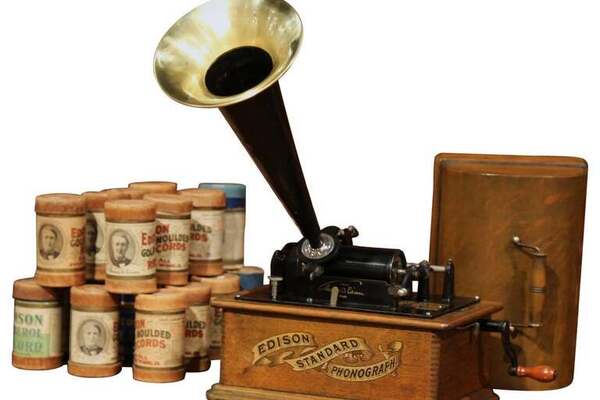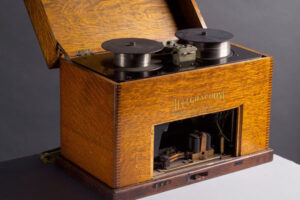Thomas Edison is widely recognized as one of the most influential inventors in history. His contributions to various fields, ranging from electricity to motion pictures, have left a lasting impact on society. However, there is one invention of his that often goes unnoticed in today’s digital age – the cylinder phonograph.
The cylinder phonograph holds great importance in the history of audio recording and playback. It was one of Edison’s earliest inventions and paved the way for the development of modern sound technology. In this blog post, we will explore the fascinating world of the cylinder phonograph and its significance in shaping our entertainment and music industries.
Table of Contents
Background
Thomas Edison was one of history’s most celebrated inventors. He was responsible for numerous groundbreaking creations that revolutionized various industries. One of his early inventions was the cylinder phonograph, which played a vital role in the history of sound recording and playback.
During Edison’s time, there was a pressing societal need for a device that could capture and reproduce sound. People desired a way to record important speeches, music performances, and even personal messages. Recognizing this demand, Edison set out to develop a device that could fulfill this desire.
The development of the cylinder phonograph marked a significant milestone in Edison’s career. It was a breakthrough invention that allowed for the first time the recording and playback of sound. When Edison unveiled this revolutionary device to the public, it was met with awe and astonishment. The idea of capturing and preserving sound was almost unimaginable at that time.
In the next section, we will explore the efforts made to rediscover and revive the cylinder phonograph, as well as the renewed fascination with experiencing the early recordings it produced.
Functionality and Design of the Cylinder Phonograph
The cylinder phonograph, invented by Thomas Edison in the late 19th century, revolutionized the way sound was recorded and played back. At its core, the cylinder phonograph was a mechanical device that captured and reproduced sound through a series of intricate mechanisms.
The working principle of the cylinder phonograph can be broken down into three main components: the diaphragm, the stylus, and the rotating cylinder. When a sound was emitted, it would cause the diaphragm to vibrate. These vibrations were then transmitted to the stylus, which would follow the grooves of the rotating cylinder. As the stylus moved along the grooves, it would produce corresponding vibrations that could be amplified and heard through a speaker.
Edison’s design choices played a crucial role in the functionality of the device. He recognized the importance of a precise and consistent groove pattern on the cylinder to ensure accurate sound reproduction. To achieve this, he opted for a hard wax cylinder that could be easily engraved with the sound waves. Moreover, he developed a reliable system for rotating the cylinder at a constant speed, allowing for consistent playback.
One key design feature of the cylinder phonograph was its ability to record and play back sound. This dual functionality made it a versatile device that could be used for personal recordings, capturing live performances, or even preserving historical events. Edison’s design also included an adjustable stylus, which allowed for different levels of sensitivity depending on the desired volume and clarity.
The impact of these design choices was immense. The cylinder phonograph enabled the mass production and distribution of recorded sound, forever changing the world of entertainment and music. It allowed people to experience the same performance over and over again, regardless of time or location. The device became a symbol of innovation and technological advancement, solidifying Edison’s reputation as one of history’s greatest inventors.
In conclusion, the cylinder phonograph’s functionality and design were pivotal factors in its success and impact. Thomas Edison’s meticulous attention to detail, from the precision of the cylinder grooves to the adjustability of the stylus, ensured that the device was capable of capturing and reproducing sound with remarkable accuracy. The cylinder phonograph’s design choices not only facilitated the recording and playback of sound but also influenced the direction of audio technology for years to come.
Impact and Legacy of the Cylinder Phonograph
The cylinder phonograph invented by Thomas Edison had a significant impact on various aspects of society, recording, and preserving history. This groundbreaking technology revolutionized the way sound could be captured and played back, leaving a lasting legacy in the realms of entertainment, music, and early audio recordings.
Recording and Preserving History
One of the most significant contributions of the cylinder phonograph was its role in recording and preserving history. Prior to its invention, the only way to experience sound was through live performances. The cylinder phonograph allowed for the first time the ability to capture and store sounds, providing a valuable tool for recording historical events, speeches, and other significant moments.
Impact on Entertainment, Music, and Early Audio Recordings
The introduction of the cylinder phonograph brought a whole new dimension to entertainment and music. It enabled people to listen to music and performances in the comfort of their own homes, revolutionizing the way people experienced and consumed music. With its ability to capture and reproduce sounds, the cylinder phonograph played a crucial role in the early development of the music industry, giving rise to the popularity of recorded music.
Furthermore, the cylinder phonograph paved the way for the development of other audio recording technologies. It served as the foundation for the creation of records, vinyl, and eventually, modern digital music formats. It laid the groundwork for the technological advancements that followed, shaping the way we listen to and appreciate music today.
Limitations compared to Modern Technology
Although the cylinder phonograph was a groundbreaking invention for its time, it had its limitations compared to modern technology. Firstly, the sound quality of the recordings was limited by the technology available at the time. The recordings often had a significant amount of background noise and lacked the fidelity and clarity that we have come to expect from modern audio recordings.
Additionally, the cylinder phonograph was a bulky and delicate device. It required frequent maintenance and careful handling to ensure that the sound quality remained intact. With the advent of more portable and user-friendly recording and playback devices, such as cassette tapes and digital formats, the cylinder phonograph gradually faded into obscurity.
Despite these limitations, the cylinder phonograph remains a significant milestone in the history of technology and audio recording. Its impact on society, entertainment, and music cannot be understated, making it a pivotal part of Thomas Edison’s legacy and a reminder of the importance of preserving and appreciating forgotten technologies.
Forgotten Technology?
The cylinder phonograph, once a revolutionary invention by Thomas Edison, has sadly become a forgotten technology. It is intriguing to explore the decline in its popularity and understand why it has been overshadowed by alternative recording and playback devices.
In the early 20th century, the cylinder phonograph was widely embraced for its ability to record and reproduce sound. However, advancements in technology soon led to the rise of new and more convenient devices, such as the gramophone and later, the vinyl record player. These alternatives offered improved sound quality and ease of use, ultimately overshadowing the cylinder phonograph.
Moreover, the cylinder phonograph required manual operation, which limited its appeal among consumers seeking more automated and user-friendly options. The rise of radio broadcasting, followed by the introduction of tape recorders, further diminished the cylinder phonograph’s prominence.
Additionally, the cylinder phonograph faced several technical limitations. Its cylindrical shape restricted the amount of sound that could be recorded, and the fragility of the wax cylinders made them prone to damage. These challenges, combined with the emergence of newer, more compact technologies, gradually rendered the cylinder phonograph obsolete.
Nevertheless, in recent years, there has been a growing interest in reviving and preserving the cylinder phonograph. Historians and enthusiasts have made efforts to restore and maintain these forgotten devices, recognizing their historical significance. Several projects have focused on digitizing and archiving early recordings, allowing modern audiences to experience the unique sound quality of the cylinder phonograph once again.
In conclusion, the decline of the cylinder phonograph can be attributed to the rise of alternative recording and playback devices, as well as its own technical limitations. However, efforts to rediscover and revive this forgotten technology highlight the importance of preserving and appreciating inventions from the past. By doing so, we can gain a deeper understanding of our technological heritage and the impact it has had on society.
Rediscovery and Revival
Over the years, historians and enthusiasts have made concerted efforts to restore and preserve cylinder phonographs. These dedicated individuals recognize the historical and cultural significance of this forgotten technology and are determined to ensure its longevity.
One notable event that highlights the revival of the cylinder phonograph is the Annual Cylinder Record Extravaganza. This gathering brings together collectors, researchers, and enthusiasts from around the world to showcase their collections, discuss preservation techniques, and even demonstrate the playback of these early recordings. It is an opportunity for people to immerse themselves in the unique sounds and experiences of the past.
In addition to events like the Extravaganza, various projects have emerged that aim to digitize and archive these fragile recordings. Thanks to advancements in technology, it is now possible to convert the analog sounds of cylinder phonographs into digital formats, ensuring their long-term preservation and accessibility to a wider audience.
So why this renewed interest in experiencing the unique sound quality of these early recordings? One reason is the nostalgia and curiosity associated with rediscovering our technological roots. The cylinder phonograph offers a charming and authentic way to listen to music and other recordings from a bygone era, transporting listeners to a time when these sounds were a novelty.
Moreover, there is also a growing appreciation for the warmth and richness of the sound quality produced by cylinder phonographs. In an age dominated by digital perfection and mass production, the distinct imperfections and nuances captured by these early recording devices captivate modern ears seeking a more organic and vintage audio experience.
In conclusion, the revival of the cylinder phonograph is a testament to the enduring fascination with forgotten technologies. Through the efforts of historians and enthusiasts, these devices are being restored, preserved, and celebrated. As we continue to explore and appreciate our technological heritage, it is vital that we recognize and protect these valuable pieces of history for future generations.
Conclusion
The cylinder phonograph played a crucial role in Thomas Edison’s legacy as one of the most significant inventors in history. Its development marked a breakthrough in recording and playing back sound, fulfilling a societal need for a device capable of capturing and preserving audio.
With its unique functionality and design, the cylinder phonograph revolutionized the world of entertainment and music. By describing how the cylinder phonograph works and highlighting its key components and mechanisms, it becomes evident why it was such a groundbreaking invention. Edison’s design choices not only impacted the device’s functionality but also influenced the future of audio recording technology.
The impact and legacy of the cylinder phonograph are immense. It not only allowed for the recording and preservation of history but also played a vital role in the entertainment industry. The limitations of the cylinder phonograph compared to modern technology have to be acknowledged, but it is important to appreciate the immense contributions it made during its time.
However, as technology progressed, the popularity of the cylinder phonograph declined. Alternative recording and playback devices emerged, eventually overshadowing Edison’s invention. The rise of new and more efficient technologies led to the cylinder phonograph being forgotten and overshadowed by its successors.
Nevertheless, there has been a resurgence of interest in the cylinder phonograph in recent years. Historians and enthusiasts have made efforts to restore and preserve these forgotten technologies. Through their dedication, the unique sound quality and historical importance of cylinder phonographs have been rediscovered and appreciated once again.
In conclusion, the cylinder phonograph holds a significant place in Thomas Edison’s legacy and the history of technology. It is crucial to preserve and appreciate forgotten technologies like the cylinder phonograph, as they provide valuable insights into the development of modern inventions. By suggesting possible avenues for future exploration and research, it is possible to keep these forgotten technologies alive and continue learning from their past contributions.




